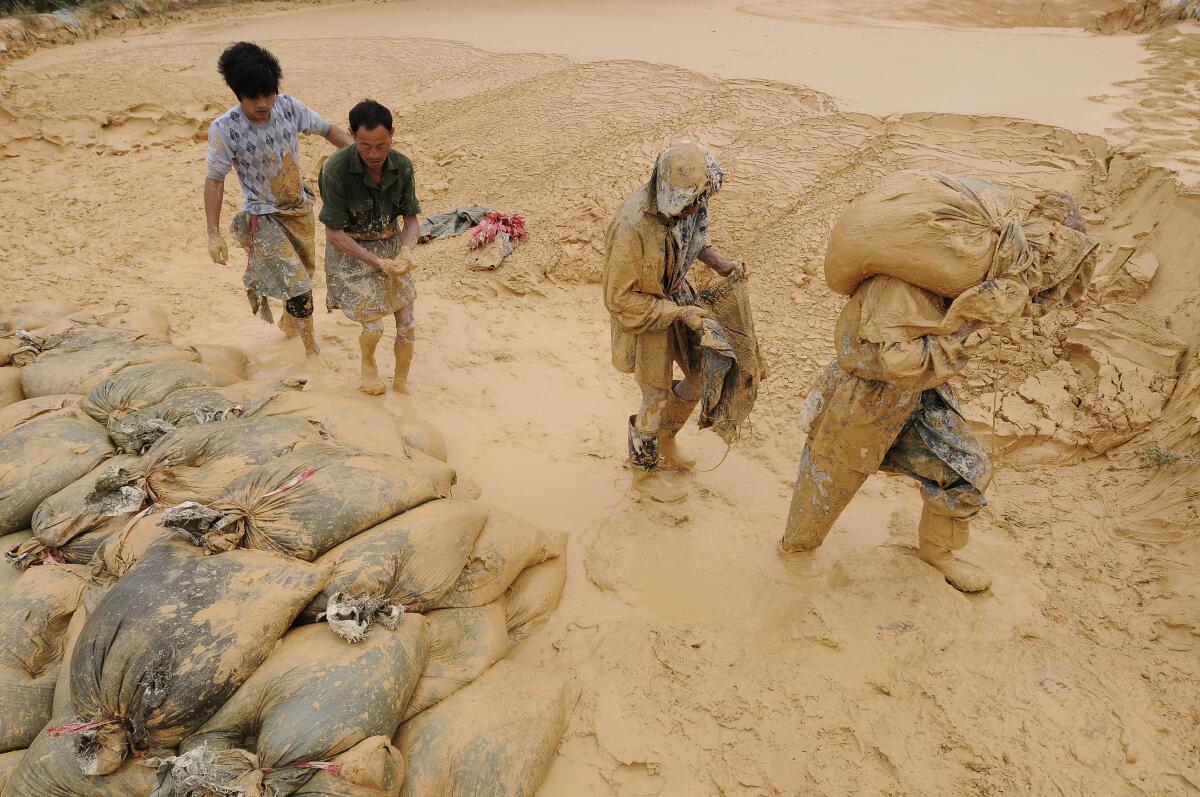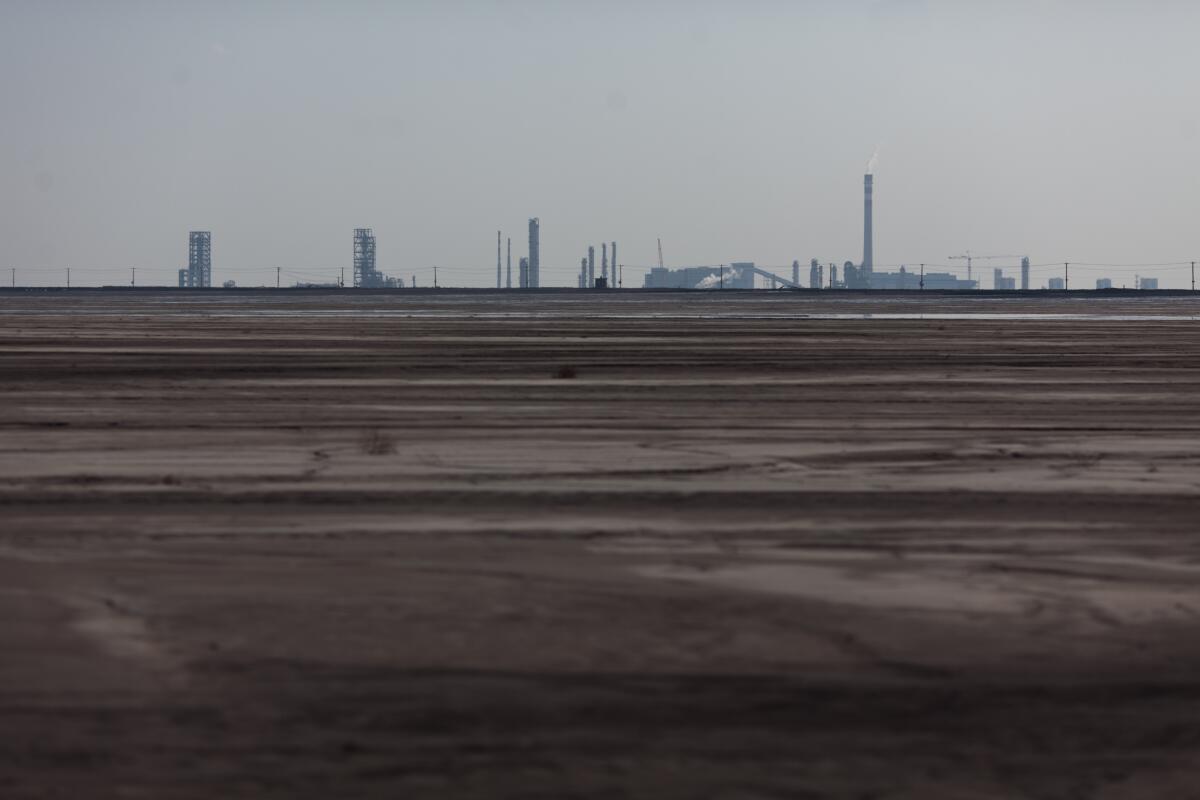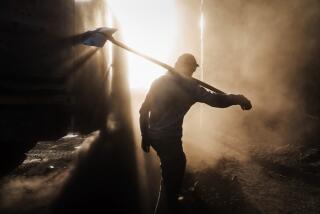The hidden costs of China’s rare-earth trade

- Share via
NANNING, China — The villagers came out in flip-flops and straw hats, bearing white banners with handwritten characters that read: “Return the land to me.”
They were farmers from Yulin in the southern province of Guangxi, where a state-owned enterprise was about to pour acids into large pits in the soil to extract one of China’s key resources: rare earth.
Rare earth is a group of 17 elements, sometimes found in minerals containing uranium, that are critical to high-tech products including smartphones, wind turbines, electric cars and military equipment such as missile systems.
They are called “rare” not because they are necessarily hard to find, but because the extraction process is expensive and toxic. In the last two decades, China has come to dominate global rare-earth production by investing in mining and processing without enforcing adequate environmental safeguards.
By turning a blind eye to the environmental and human costs, major manufacturers have helped support China’s expansion while reaping financial benefits because of the relatively low cost of supplies.
The results are jarring: In mineral-rich regions of China, poisoned water and soil have caused abnormal disease rates in “cancer villages” from which impoverished residents cannot afford to move. Crops and animals have died around a crusty lake of radioactive black sludge formed from mining waste near a major mining site in Baotou, Inner Mongolia. It’s so large that it is visible by satellite.

Beijing has said it is cracking down on illegal mining and consolidating operations under six state-owned enterprises. But in Guangxi, villagers protest that the state-owned companies are as bad as illegal operators, if not worse, because they can poison the ground and air with the support of local authorities.
Qin Yongpei, a Nanning-based lawyer whose license was revoked in a national crackdown on human rights defenders in 2018, has been following rare-earth cases since 2015. He continues to assist villagers by recruiting other lawyers to take on their cases.
In 2008, a company called Chinalco Guangxi Yulin Rare Earth Development Co. Ltd. began mining around a highway under construction near Zhongshan, another rural part of Guangxi province, saying it was reclaiming resources from the earth for recycling. But it kept mining years after the highway was completed, Qin said.
Locals said they eventually noticed the smell of sulfur and gaping pits of contaminated wastewater seeping into their farms and villages. In 2015, they protested, hoisting signs that read, “Mountains of gold and silver are not as good as mountains of blue and green.”
Fifteen Zhongshan protesters were arrested that year, and 10 more two years later, accused of “picking quarrels and stirring up trouble.”
In Yulin, more than 10 protesters were detained in May 2018 when villagers resisted the same company’s attempt to mine more rare earth. In one video, a protester walks up to a mine worker wearing an orange hard hat with “Chinalco” written on it.
“Where did you get the right, who approved you to come and mine here?” the villager asks. “You didn’t go through us villagers’ approval, to forcefully come and mine here and destroy our homeland and destroy us. Who gave you the power?”

Protesters confront a worker at a rare-earth mine in China.
In other recordings, riot police in blue uniforms confront the crowd with batons and shields. Some of the villagers are holding spades. One video shows policemen beating a group of villagers.
Seven villagers in Yulin remain in detention, according to Qin.
Rare earth’s status as a critical resource has made local authorities afraid to take action against state-owned mining companies, Qin said.
“Rare earth is a special-privilege resource,” said Qin. “Other minerals are mined with local permits from the local government. Rare-earth permits come from the central government.”
Rare earth caught global attention when President Xi Jinping visited a rare-earth permanent magnet factory in Jiangxi in May, days after the White House raised tariffs on imports from China.
Chinese state media sent signals that China could restrict rare-earth exports to pressure American companies, warning in editorials that “if anyone wants to use imported rare earths against China, the Chinese people will not agree.”
China accounted for about 71% of the world’s rare-earth output last year and supplied 80% of U.S. rare-earth imports from 2014 to 2017, according to the U.S. Geological Survey. Experts believe illegal mines in China are providing more through the black market.
The U.S. has exempted rare-earth imports from tariffs, while China has placed tariffs of 25% on rare earth from the United States.
Though trade war tensions have relaxed somewhat since President Trump and Xi’s meeting at the recent Group of 20 summit, experts say China’s hold on rare earth remains a risk to the tech supply chain, especially as more countries transition to green energy.
Yet as long as supply chain decisions are driven by prices regardless of environmental costs or geopolitical risk, China will continue to dominate rare-earth mining, experts said.
China also aims to use the minerals to produce its own versions of permanent magnets and electric vehicles. That goal was spelled out as long ago as 1992, when then-leader Deng Xiaoping said: “The Middle East has oil; China has rare earths.”
In 2016, China released a five-year plan specifically for rare earths. A Made in China 2025 initiative includes a target of having 80% of electric vehicles sold in the country domestically produced by then.
China’s advancement up the supply chain has been in plain sight for decades and enabled by companies’ prioritization of low costs above supply security, said Gareth Hatch, co-founder of Technology Metals Research.
“I don’t subscribe to the view that China has some nefarious 20-year plan to screw the West through strategic materials. This pattern of increasing technology and complexity of the supply chain, it’s been right there in plain sight,” Hatch said.
“The market has done this to itself by saying we’re going to go for the lowest cost at any cost,” he said.
David Abraham, a Resource Security fellow at the nonpartisan think tank New America, said China’s investment in rare-earth research and development far surpasses that of the United States. “I go to a rare-earth conference in the U.S. in 2015 and about 10 people are there. I go to a conference in Lanzhou and 400 people are there,” Abraham said.
In 2010, alarmed by China cutting rare-earth exports to Japan, Congress asked the Government Accountability Office to evaluate the U.S. defense supply chain’s vulnerabilities.
But the U.S. has made little advancement in diversifying the supply, partially because few other countries are willing to copy China’s low-cost, high-pollution version of rare-earth processing. One of the few non-Chinese suppliers of rare earths is the Australian company Lynas, which has faced public protests in Malaysia, where it processes rare earth mined in Australia, over concerns involving radiation poisoning and water contamination.
There is only one rare-earth mine in the United States: the Mountain Pass mine in San Bernardino County. It went bankrupt in 2016 and only resumed functioning in 2018, but still sends its mined rare-earth ore to China for processing.

Lynas recently signed an agreement with Blue Line Corp. to build a rare-earths separation facility in Texas.
Back in 2010, the Government Accountability Office reported that it could take up to 15 years for the U.S. to catch up to China. In June, the Commerce Department issued a critical minerals report that called for reducing foreign dependence in the military supply chain.
“Supply chains can move. These supply chains cannot,” Abraham said. “You can’t move a mine, you can’t move a processing facility, and that’s the real challenge. They’re in China.”
The key to China’s advantage is not state investment, analysts say, but in allowing Chinese citizens to shoulder the burdens of pollution. The chemicals used for rare-earth extraction are corrosive to bones and teeth. When mined alongside other metals, the process can contaminate water with radioactive residue, said Eric Liu, a toxics campaigner for Greenpeace in Beijing.
“As long as there is surface or underground water, all kinds of dangerous materials will go into the surroundings of the mining area and all the farms nearby,” he said. “They are pouring chemical acids directly into the earth.”
Ma Jun, director of the Institute of Public and Environmental Affairs, said that nonetheless, many rural residents “have no choice” but to live in contaminated areas.
“They dig a well and try to dig deeper until they cannot afford digging more and have to depend on that well,” Ma said. “Then they get sick.”
The Chinese government estimates it would cost $5.5 billion to clean up environmental damage from years of rampant illegal mining in Jiangxi. Environmentalists say the state-owned companies are employing the same sort of harmful practices, in some cases with even more impunity.
Some environmentalists suggest rare earth should be treated as a conflict mineral, the way “blood diamonds” are, especially as demand increases.
“If you’re a shareholder of Apple or whatever company might use rare earth in their products, they need to look into the risks. It’s not just about supply disruption, it’s also about reputation,” said Liu Hongqiao, a researcher who has published reports on rare-earth pollution.
Global demand and unwillingness to invest in more expensive and environmentally responsible mining are the drivers of China’s black market and harmful practices, said Eugene Gholz, a political science professor at the University of Notre Dame.
“Some companies are making a judgment that they’re not comfortable with people dumping acid in the middle of a forest in southern China,” Gholz said. “But they’re not interested enough to spend the money to drive up the price of heavy rare earth to the point where they’re profitably produced from the Australian mine.”
When a Times reporter approached villagers in Zhongshan, police threatened the villagers, then blocked the road so no one could enter or exit.
A Chinalco representative said by phone that the Guangxi company had a cooperative relationship with her company. It is listed online as a state-owned enterprise. She denied knowledge of protests or villagers’ arrests.
No one answered repeated calls to the Guangxi company’s listed phone number.
Yulin villagers have told volunteer supporters that they have stopped sending their children to school as a protest.
“The parents said, ‘We don’t even have safe soil and water. What’s the point of going to school?’ ”
When the villagers posted banners, they were arrested, one volunteer said.
The volunteers, who asked that their names not be published to protect them from arrest, questioned whether the mining and processing are worth it.
“Wealth and power at what cost? You’re destroying your people’s lives,” one said. “If you’re such a strong country, you should be supporting and protecting the weak, not asking the weak to sacrifice for you.”
More to Read
Sign up for Essential California
The most important California stories and recommendations in your inbox every morning.
You may occasionally receive promotional content from the Los Angeles Times.










